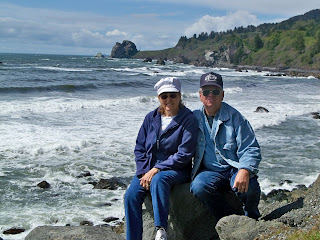
We spotted these elk in a field on the Newton Drury Scenic Parkway on our way to the Coastal Drive in Northern California.

One of our destinations was this WW II Radar Station on the California coast. It was designed to protect the U.S. mainland after the bombing of Pearl Harbor. At one time, Japanese subs operated in off shore waters and actually shelled some shipping operations and oil installations off the coast of California and Oregon. To protect from an invasion, the U.S. Army built "farm" buildings. The cinder block structures, complete with shingled roofs and fake windows and dormers house an early warning radar station.
The buildings housed diesel generators, electronic equipment and two 50-caliber anti aircraft machine guns. As the last relatively intact WW II post, Radar Station B 71 was placed on the National Register of Historic Places on April 19, 1978
.

Then on to the Jedediah Smith Redwoods State Park where we took the Highland Hill Road through the park. The road is NOT recommended for motor homes or trailers as there are many sharp turns around these huge trees.

Redwoods often grow from "burls" at the base of the mother tree as you can see here. Whoa! Is that Stanley????

The harbor at Crescent City is very pretty, named for its shape, a crescent. It has been an important port for almost 150 years. The lumber industry shipped much of the redwood, fir, and spruce cut in nearby forests by schooner to poert salong the west coast. Fishing is another important industry.
The Battery Point Lighthouse was first lit in 1856. Since then the structure has weathered many changes including automation in 1953 and a tidal wave that flooded the peninsula in 1964 from the earthquake that struck Alaska. Twenty nine blocks in Crescent City were destroyed at that time. The lighthouse was spared as the tidal wave struck at such an extreme angle the structure was protected.
Accessible only by foot at low tide, Battery Point is now a Maritime Museum. The light is reputed to house a resident ghost, seen by at least six different people, who have heard its sea-booted feet slowly climbing the tower steps during storms.

We found this crab on the beach when we stopped to have a picnic lunch. Notice how dark the sand is here, so different from the beautiful white sands of the Gulf Coast.
We took this picture while walking on the beach one evening. These rocks, which are all along the California and Oregon coasts are known as "sea stacks." These immense blocks of highly resistant rocks of chert, greenstone, and sandstone are within a matrix of softer, more easily eroded rock called mudstone. The more resistant blocks survive the erosive power of the ocean to form the sea stacks that you see just offshore.
How many times did you see Stanley??








No comments:
Post a Comment